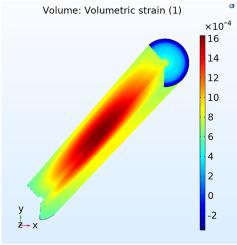当前位置:
X-MOL 学术
›
Prog. Nucl. Energy
›
论文详情
Our official English website, www.x-mol.net, welcomes your
feedback! (Note: you will need to create a separate account there.)
Thermal-hydraulic and solid mechanics safety analysis for VVER-1000 reactor using analytical and CFD approaches
Progress in Nuclear Energy ( IF 3.3 ) Pub Date : 2020-12-01 , DOI: 10.1016/j.pnucene.2020.103568 Mohamed Y.M. Mohsen , Abdelfattah Y. Soliman , Mohamed A.E. Abdel-Rahman
Progress in Nuclear Energy ( IF 3.3 ) Pub Date : 2020-12-01 , DOI: 10.1016/j.pnucene.2020.103568 Mohamed Y.M. Mohsen , Abdelfattah Y. Soliman , Mohamed A.E. Abdel-Rahman

|
Abstract Neutronic, thermal-hydraulics, and solid mechanics computations were used to study the different VVER-1000 reactors' operational conditions for the steady-state and the transient state. The main objective of these studies is to investigate the safe operating conditions, which is essential in determining the reactor safety limits. The coupling between different physics enables a better understanding of reactor phenomena and enhanced accuracy by reducing the assumption needed for separate calculations for different physics. MCNPX code is used to provide the source power distribution for two themes of calculations. The first theme is the analytical solution using MATLAB software, and the second theme is the finite element coupled physics using COMSOL Multiphysics. Analytical solutions using MATLAB software and results from COMSOL-Multiphysics were used to simulate the uncoupled analytical models and coupled models, respectively. The coupled theme provide feedbacks between different physics by iterating the solution between different physics; such as solving the heat transfer with taking into consideration the variation of the coolant velocity along the coolant channel and solving solid mechanics with taking into consideration the change of either the fuel and the clad temperatures distribution (thermal load) or the change in the coolant pressure (pressure load). While in the uncoupled solutions, certain assumptions reflect an average behavior for the effect of other physics on the physics under concern, such as the average pressure of the coolant and the average value for the coolant velocity. The obtained results are verified by comparing it to WIMS D-4 for neutronic calculations and COPERA-EN code for the thermal-hydraulic analytical solution. Also, thermal-hydraulic results by both coupled and uncoupled themes are verified against results from the final safety analysis report. The Departure from Nucleate Boiling Ratio (DNBR) and the Minimum Departure from Nucleate Boiling Ratio (MDNBR) were applied for the investigation of VVER-1000 reactor safety parameters. Solid mechanics, fluid dynamics and heat transfer were used to compute the maximum stress/maximum volumetric strain acting on both fuel and cladding material. Results from both methods satisfied the limits addressed by the designer and shows a good agreement with the other published works that used WIMS D-4 for neutronic calculations and COBRA-EN code for thermal-hydraulic calculations analytically. in addition, the maximum stress occurring on the fuel and clad materials didn't exceed the yield stress. Furthermore, the fuel material displacement didn't exceed the Helium gap thickness, which means the surface contact between the fuel and the clad material is impossible that prevents the chemical interaction between both fuel and clad at 1135 K.
中文翻译:

使用分析和 CFD 方法对 VVER-1000 反应堆进行热工水力和固体力学安全分析
摘要 中子、热工水力和固体力学计算被用来研究不同VVER-1000 反应堆在稳态和瞬态下的运行条件。这些研究的主要目的是调查安全运行条件,这对于确定反应堆安全限值至关重要。不同物理场之间的耦合可以减少对不同物理场进行单独计算所需的假设,从而更好地理解反应堆现象并提高准确性。MCNPX 代码用于为计算的两个主题提供源功率分配。第一个主题是使用 MATLAB 软件的解析解,第二个主题是使用 COMSOL Multiphysics 的有限元耦合物理。使用 MATLAB 软件的分析解决方案和 COMSOL-Multiphysics 的结果分别用于模拟非耦合分析模型和耦合模型。耦合主题通过迭代不同物理之间的解决方案来提供不同物理之间的反馈;例如考虑沿冷却剂通道的冷却剂速度的变化来求解热传递,以及考虑燃料和包层温度分布(热负荷)或冷却剂压力变化的变化来求解固体力学(压力负荷)。而在非耦合解决方案中,某些假设反映了其他物理场对相关物理场影响的平均行为,例如冷却剂的平均压力和冷却剂速度的平均值。通过将其与用于中子计算的 WIMS D-4 和用于热工水力分析解决方案的 COPERA-EN 代码进行比较来验证所获得的结果。此外,耦合和非耦合主题的热工水力结果将根据最终安全分析报告的结果进行验证。偏离核沸腾比 (DNBR) 和最小偏离核沸腾比 (MDNBR) 用于研究 VVER-1000 反应堆安全参数。固体力学、流体动力学和传热被用来计算作用在燃料和包壳材料上的最大应力/最大体积应变。两种方法的结果都满足了设计者提出的限制,并且与其他使用 WIMS D-4 进行中子计算和 COBRA-EN 代码进行分析热工水力计算的已发表作品非常吻合。此外,燃料和复合材料上出现的最大应力没有超过屈服应力。此外,燃料材料的位移没有超过氦气间隙厚度,这意味着燃料和包壳材料之间的表面接触是不可能的,从而阻止了燃料和包壳在 1135 K 下的化学相互作用。
更新日期:2020-12-01
中文翻译:

使用分析和 CFD 方法对 VVER-1000 反应堆进行热工水力和固体力学安全分析
摘要 中子、热工水力和固体力学计算被用来研究不同VVER-1000 反应堆在稳态和瞬态下的运行条件。这些研究的主要目的是调查安全运行条件,这对于确定反应堆安全限值至关重要。不同物理场之间的耦合可以减少对不同物理场进行单独计算所需的假设,从而更好地理解反应堆现象并提高准确性。MCNPX 代码用于为计算的两个主题提供源功率分配。第一个主题是使用 MATLAB 软件的解析解,第二个主题是使用 COMSOL Multiphysics 的有限元耦合物理。使用 MATLAB 软件的分析解决方案和 COMSOL-Multiphysics 的结果分别用于模拟非耦合分析模型和耦合模型。耦合主题通过迭代不同物理之间的解决方案来提供不同物理之间的反馈;例如考虑沿冷却剂通道的冷却剂速度的变化来求解热传递,以及考虑燃料和包层温度分布(热负荷)或冷却剂压力变化的变化来求解固体力学(压力负荷)。而在非耦合解决方案中,某些假设反映了其他物理场对相关物理场影响的平均行为,例如冷却剂的平均压力和冷却剂速度的平均值。通过将其与用于中子计算的 WIMS D-4 和用于热工水力分析解决方案的 COPERA-EN 代码进行比较来验证所获得的结果。此外,耦合和非耦合主题的热工水力结果将根据最终安全分析报告的结果进行验证。偏离核沸腾比 (DNBR) 和最小偏离核沸腾比 (MDNBR) 用于研究 VVER-1000 反应堆安全参数。固体力学、流体动力学和传热被用来计算作用在燃料和包壳材料上的最大应力/最大体积应变。两种方法的结果都满足了设计者提出的限制,并且与其他使用 WIMS D-4 进行中子计算和 COBRA-EN 代码进行分析热工水力计算的已发表作品非常吻合。此外,燃料和复合材料上出现的最大应力没有超过屈服应力。此外,燃料材料的位移没有超过氦气间隙厚度,这意味着燃料和包壳材料之间的表面接触是不可能的,从而阻止了燃料和包壳在 1135 K 下的化学相互作用。











































 京公网安备 11010802027423号
京公网安备 11010802027423号